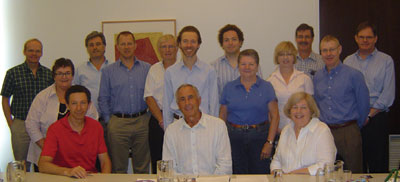Setting goals effective way to start glaucoma support organizations
Glaucoma support groups play an important role in the community, assisting in diagnosis and patient adherence.
Glaucoma support organizations offer patients and their families much-needed help and information about the disease while also raising community awareness about glaucoma, Ivan Goldberg, MBBS, FRANZCO, FRACS, said.
Dr. Goldberg is the cofounder of Glaucoma Australia, a nonprofit lay organization that supports Australian glaucoma patients and their families. Since its inception in 1988, Glaucoma Australia has been successful in offering glaucoma support meetings to hundreds of patients and their families throughout Australia, initiating and promoting the country’s annual National Glaucoma Week and recruiting many volunteers to disseminate information about the disease.
According to Dr. Goldberg, setting goals to meet glaucoma patients’ key needs is important in establishing successful support organizations. Glaucoma Australia’s methods to achieve its goals could be used anywhere in the world, he said.
The organization’s goals are to increase community awareness of the disease, support patients and raise research funds.
“Goal one is to raise community awareness, and there are strategies to do that,” Dr. Goldberg told Ocular Surgery News. “Support glaucoma patients and their families; it is a chronic disease, incurable, relatively asymptomatic, and it’s the treatment that produces symptoms, and we need, therefore, to give patients enough information so they can understand the goals of treatment. … Thirdly, it’s to raise funds for glaucoma research nationally.”
Raising awareness
Dr. Goldberg said one of the most effective ways to run a successful glaucoma support organization is to understand the importance of community awareness. According to statistics from the organization’s Web site, 50% of people with glaucoma in Australia are undiagnosed. Glaucoma Australia helps to reduce that rate through reaching out to people and educating them about the disease.
“We go into clubs that deal with people more likely to have glaucoma, like older groups, senior groups. People that play lawn bowls, for instance, have a much higher average age than people who play cricket or rugby,” he said.
 Glaucoma Australia celebrated its 21st birthday with its friends and supporters in Melbourne. Images: Lindsell B
|
The organization distributes glaucoma information pamphlets in 17 languages, to reach as many individuals in the country as possible who might be affected by the disease.
Setting up screenings at places that people might frequent, such as shopping areas, can also be effective for raising community awareness.
The media can assist by publishing information about the disease, as well as running radio interviews and television broadcasts about it, Dr. Goldberg said. Glaucoma Australia was recently successful in obtaining television time.
“We spoke about how glaucoma can rob you of your driving license, and we had a tremendous hook for the general media. We had between 90 seconds to 2 minutes of coverage on prime time, on each of the three main commercial stations,” he said.
Involving interest groups, particularly senior citizens groups, is another way to gain free publicity.
In addition, a booth at conferences for optical dispensers, optometrists and pharmacists can help raise awareness in the health professional industry about the disease, he said. Glaucoma Australia’s booths have featured information about programs that the organization runs, as well as leading glaucoma risks and how “you can have your eyes tested in as much time as it takes to have a cup of coffee,” he said.
Patient support
Directly supporting glaucoma patients is another important goal of a successful glaucoma support organization, according to Dr. Goldberg.
Glaucoma Australia has established support groups throughout Australia, setting up locations where patients can attend regular discussions. Patients and their families learn about the disease and its risk factors from local ophthalmologists, he said.
The relative cost for running the meetings is low, as they are often held on weekend afternoons in churches or community halls that are rented inexpensively, Dr. Goldberg said. However, small donations can be collected at meetings to help defray costs.
All the best aspects of the glaucoma support organization come together at the meetings, providing real encouragement to patients, he said. Such regular patient support could potentially help increase compliance and early diagnosis.
Turnout at the support group meetings has been excellent, Dr. Goldberg said, with more than 200 to 300 people attending some meetings.
Fundraising
The most effective way of treating glaucoma in the future is through research, another key goal of Glaucoma Australia. The organization raises research funds by encouraging people to donate to its research foundation. Those funds are then given to “credible scientific research committees” as research grants, Dr. Goldberg said.
Grants are typically presented to researchers at the Ophthalmology National Congress.
New goal: patient advocacy
An additional goal that is being developed is patient advocacy, Dr. Goldberg said. Officials at Glaucoma Australia have recently examined ways to ensure that glaucoma patients receive the most updated care within their health care coverage.
“A new goal … is to advocate for patient services, so the patient isn’t disadvantaged in terms of insurance and reimbursement, and in terms of laser treatment and medical therapy, access to new drugs, and new surgical procedures,” he said. – by Erin L. Boyle

- Ivan Goldberg, MBBS, FRANZCO, FRACS, can be reached at 187 Macquarie St. Park House, Floor 4, Suite 2, Sydney, NSW 2000, Australia; +61-2-9247-9972; fax: +61-2-9232-3086; e-mail: eyegoldberg@gmail.com.
